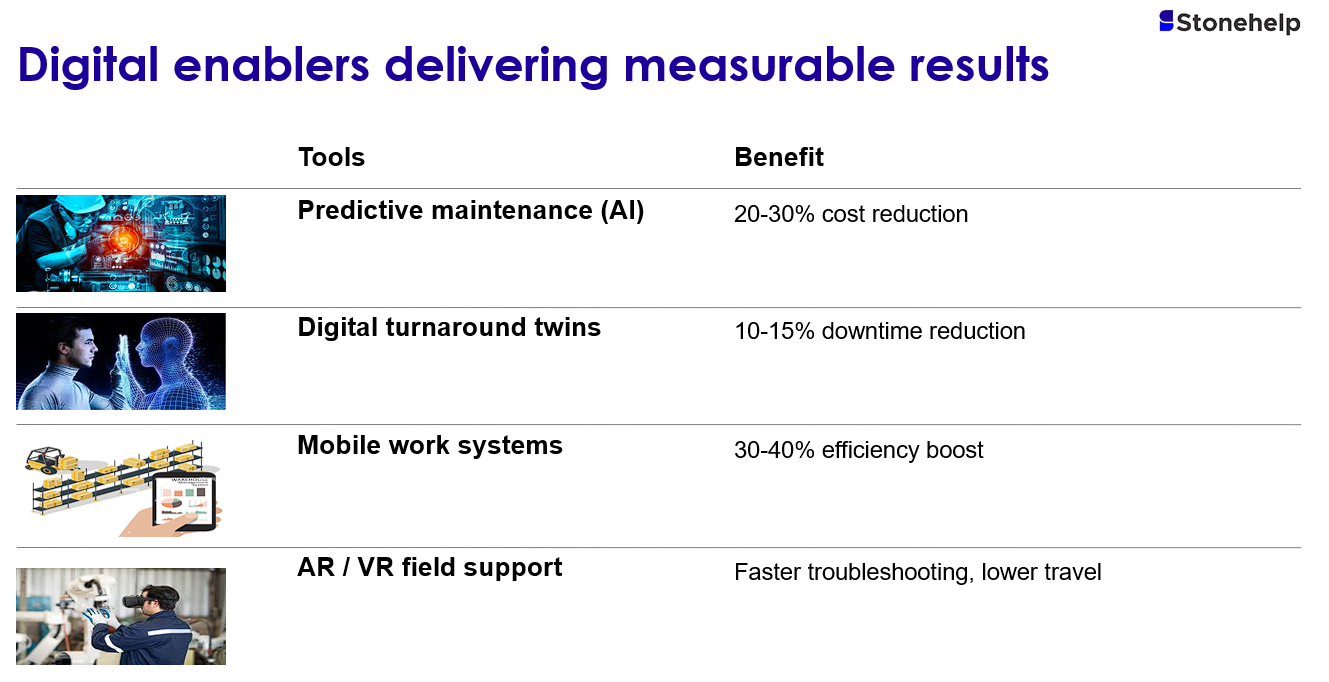
In 2025, the global downstream oil and gas sector is navigating a complex economic landscape. Amid tightening margins, shifting regulatory environments, and the accelerating energy transition, refiners are under immense pressure to cut costs while sustaining operational excellence. However, traditional levers such as across-the-board budget cuts or headcount reductions are no longer effective or sustainable. Instead, cost transformation in downstream operations now demands a nuanced, data-driven approach grounded in operational experience.
To understand where to focus, downstream cost structures are commonly broken down into three categories and each have dominant cost drivers:
- Operating expenses (Opex): Energy and utilities, maintenance, and third-party spend
- Capital expenditures (Capex): Capital projects and turnarounds
- Margin improvement: Reliability, throughput & yield, blending & giveaway and value chain optimization
Across the dominant cost drivers, four of them account for a significant share of expenditure. These are energy and utilities, third-party spend, maintenance and turnarounds. Focusing on these areas offers practical cost-saving opportunities with minimal risk to safety or reliability.
Let’s unpack each of these three buckets and examine the most practical and proven cost levers for 2025.
Operating Expenses: Cutting Costs Without Compromising Performance
a. Energy and Utilities Optimization
Energy is the single largest controllable cost in a typical refinery, often making up 50–60% of total operating expenses. In 2025, energy prices remain volatile, exacerbated by geopolitical shocks, feedstock disruptions, and carbon pricing regimes. But opportunities for optimization remain substantial.
Plants that implement robust energy monitoring systems, combined with pinch analysis and waste heat recovery strategies, often see cost reductions of $0.30–$0.90 per barrel. Key initiatives include:
- Advanced furnace tuning and oxygen control: Reduces fuel use and improves thermal efficiency
- Steam trap monitoring and condensate recovery: Cuts steam losses and reduces make-up water requirements
- Flare minimization strategies: Implementing flare gas recovery units to convert waste gas to usable fuel
- Integrated heat exchange optimization: Retrofitting exchangers and rerouting flows to maximize energy recovery
Facilities that embed energy KPIs into daily operations and benchmark performance globally outperform those that rely solely on periodic audits.
b. Maintenance and Reliability: Prioritizing the Right Work
Maintenance spend often becomes bloated over time, driven by a “fix everything” mindset. Yet up to 40% of maintenance tasks deliver little to no incremental value, according to recent field studies. In practice, implementing risk-based maintenance (RBM) and bad actor elimination programs yields immediate returns.
Refineries adopting these approaches have realized:
- 15–30% reduction in overall maintenance costs
- 25–40% decrease in backlog volume
- Lower reactive work and emergency repairs
- Improved Mean Time Between Failures (MTBF)
Key tactics include enhanced work planning, better schedule adherence, digital maintenance tracking systems, and robust root cause analysis (RCA) processes.
c. Third-Party Spend: Rationalizing Vendor Engagements
Third-party spend which encompasses contractors, OEM support, and outsourced services often escapes scrutiny. Yet it can represent hundreds of millions of dollars in annual spend for large operators. Short-term savings come from consolidating vendors, renegotiating rates, and leveraging global procurement scale.
More strategic levers involve:
- Vendor performance scorecards
- Demand rationalization (do we need the service?)
- Scope optimization (are we over-specifying?)
Companies who treat third-party spend as a strategic function—not a back-office task—see the biggest gains.
Capital Efficiency: Smarter Investments in Projects and Turnarounds
a. Turnaround Excellence
Turnarounds are critical but capital-intensive events. A poorly executed turnaround can overrun budgets by 30% and delay startup by weeks which cost tens of millions in lost opportunity. Best-in-class performers, on the other hand, are reducing turnaround costs by up to 20% and downtime by 15% through tighter planning and digital enablers.
The four cornerstones of effective turnarounds are:
- Early scope definition and freeze: Avoid late additions that balloon costs.
- Daily execution discipline: Leveraging mobile dashboards and daily reviews to stay on track.
- Contractor integration: Collaborative planning to avoid overlaps and idle time.
- Post-mortem learning: Codify lessons into playbooks and simulation models.
Digital twins, AI-driven scope forecasting, and scenario planning tools are helping refine schedules and reduce surprises. In 2022, ExxonMobil used its Digital Reality Ecosystem to map refinery units in 3D and pre-fabricate components off-site, reducing turnaround time by over a week at Baton Rouge. At Joliet, the approach cut weld work by 95% and shortened the schedule by three weeks.
b. Capital Project Optimization
In an era of constrained capital, only high-return, short-payback and safety / compliance related projects should proceed. Portfolio rationalization (i.e., cutting low-return or low-impact projects), frees up resources for truly transformational initiatives. Key strategies include:
- Zero-based capital budgeting
- Stage-gated project approvals
- Benchmarking cost per barrel of throughput added
Operators are also staging investments to reduce exposure and align capital strategy with energy transition goals, such as renewable integration and hydrogen-ready upgrades.
Margin Uplift: Making Every Barrel Count
Improving refining margin is not just about cutting costs, it’s about maximizing yield and optimizing the entire value chain.
a. Throughput and Yield Optimization
Yield is where profitability lives. In 2025, leading refiners are optimizing crude selection, feedstock blending, and unit severity based on real-time market signals. Digital twins and LP models are being refreshed more frequently to reflect operational and market realities.
Notable strategies:
- Dynamic Crude Ranking Systems
- Advanced Process Control (APC) and Catalyst Optimization
- Real-time Market-Based Setpoint Adjustments
This delivers $0.50–$1.00/bbl margin improvement for agile operators.
b. Product Blending and Giveaway Reduction
Blending optimization tools, especially for gasoline and distillates, enable tighter control of product specs, reducing giveaway and increasing product value. Reducing blendstock overuse and managing octane/gasoline pool optimization yields rapid benefits.
c. End-to-End Value Chain Optimization (VCO)
Full value chain optimization, from crude acquisition to product placement, unlocks synergy across refining, trading, logistics, and marketing. Key enablers:
- Integrated LP-Scheduling-Execution platforms
- Crude-switching arbitrage capabilities
- Cross-site intermediate movements
A coordinated VCO approach can yield $30–$85 million annually for mid-sized refiners, according to recent benchmarks.
Integrating Digital and Organizational Enablers
Across all three cost categories, digital transformation acts as a force multiplier. But tools alone are not enough; success depends on strong governance, empowered program management offices (PMOs), and cross-functional ownership.

In parallel, organizational enablers like career-path rotation programs, incentive alignment, and performance back casting are proving essential for sustaining transformation.
A Call to Strategic Action
In 2025, cost improvement in downstream operations is not about cutting deeper, it is about cutting smarter. By focusing on three high-impact areas: Opex optimization, capital efficiency, and margin uplift, refiners can unlock significant savings without compromising safety, reliability, or growth.
The data is clear. The capabilities exist. The opportunity is massive.
Leaders who act decisively, invest in cross-functional alignment, and operationalize these levers at scale will emerge more agile, more profitable, and better positioned for a lower carbon future
Authored by
Abimbola Osho and Abisola Otesile